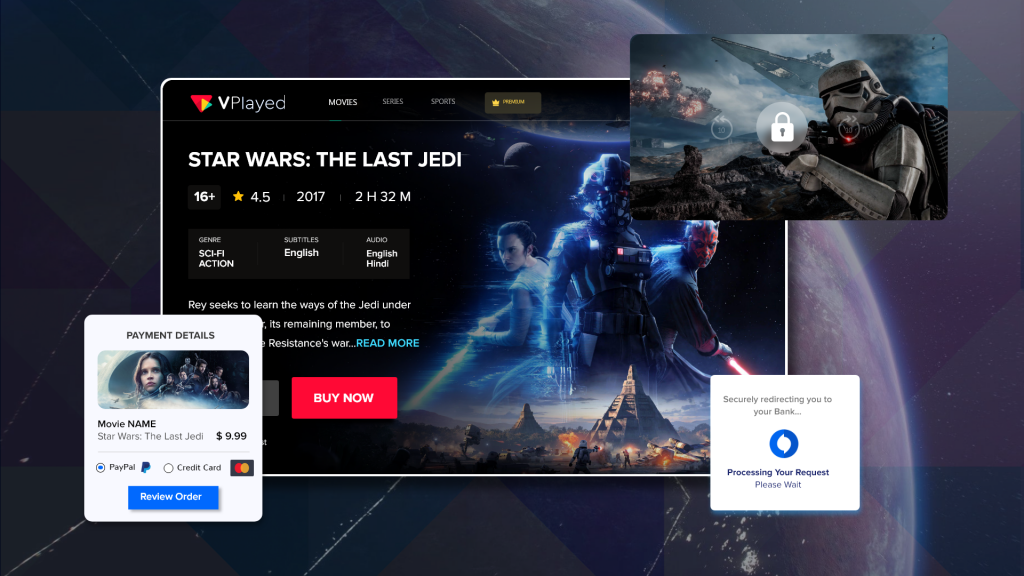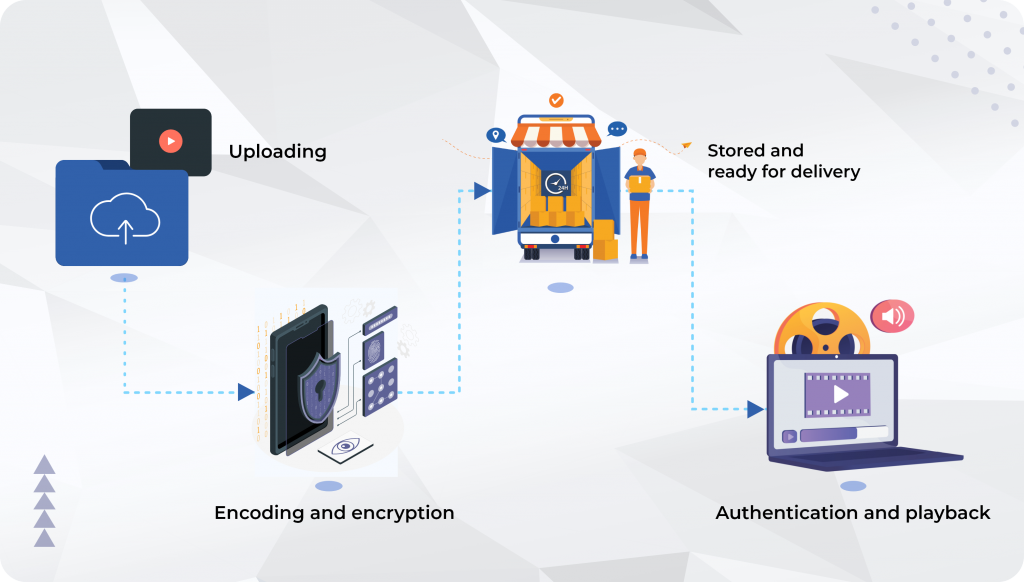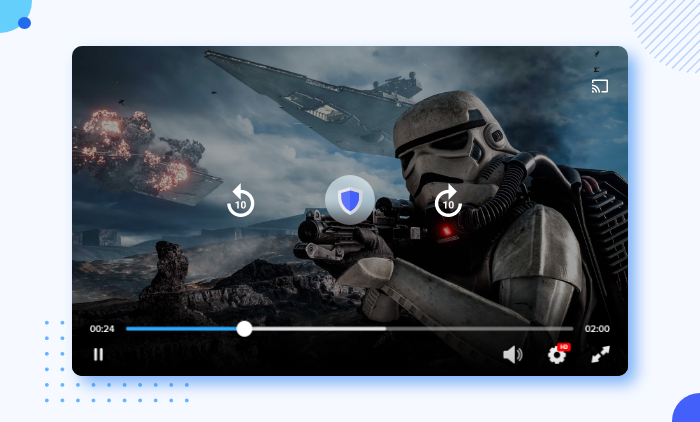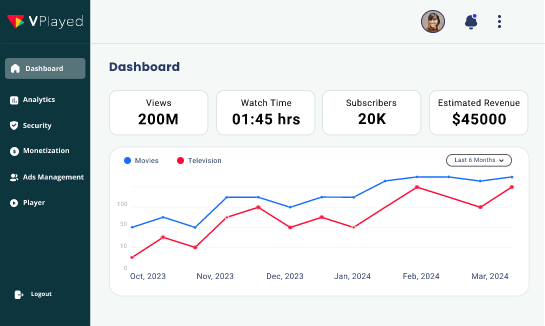What is DRM and How Can it Protect Your Online OTT Video Content?

OTT platforms are all the rage for those looking to consume video content on the go. However, anyone planning to provide such a service, including live sports, movies, and UHD programming, will need to consider the security of its content. Despite the many legal ways to stream content today, unlicensed use and piracy are still rampant.
As a result, securing OTT platform content becomes a top priority for video streaming platform providers to ensure their users have a safe and enjoyable experience. If you’re wondering how to secure videos on a website meant for streaming, the surest method ensuring secure OTT content delivery is through Digital Rights Management (DRM).
Table of Contents
What is DRM?

DRM is used to collectively refer to the tools and systems that protect and monetize copyrighted digital material and intellectual property rights. They ensure that the misuse and theft of such content don’t occur, especially over IP pay-TV services that are transmitted over the internet.
Digital content is traditionally protected through encryption, with those who have a secret key being able to decrypt and view the content. However, when it came to light that the key alone wasn’t sufficient to protect content, DRM and other business rules on how, when and by whom a key could be used were introduced. If you’re wondering how to implement DRM, the process remains largely similar regardless of what provider you use:
Here’s how DRM works in OTT:

- Uploading
DRM begins to protect content from the stage when it’s uploaded onto the best OTT platform. At this stage, the metadata of the content is collected and safely stored to be retrieved as and when needed — for example, when displaying the content details on the online video platform.
- Encoding and encryption
Right after upload, the digital content is encoded and encrypted using a cryptographic key. This can be done before or during streaming, depending on the platform. This way, DRM helps to protect content when it’s in transit between the video streaming server and the client-side.
- Stored and ready for delivery
Encrypted content is stored securely and ready for delivery. To be able to request delivery and playback, a user’s media player will need to have DRM-centric licensing information that is managed and sent out by a DRM license server in order to play the protected content securely and ensure OTT security.
- Authentication and playback
To ensure that only authenticated viewers are able to access protected digital content, there is a mutual certificate exchange between the DRM client and the DRM license server. Thus, the content is released to trusted playback systems alone — many major operating systems and browsers already have such a native trusted client.
Frequently experienced DRM and OTT challenges
- Many and incongruent DRM systems
Ever since OTT became a mainstream alternative to television over the last few years, quite a number of video-enabled viewing devices have cropped up. While this is highly beneficial for users, it poses a challenge on the DRM front as it could reduce the quality of the experience. To make up for the widespread device, operating system, and DRM fragmentation, secure OTT video platform providers support several DRMs — and the best way to do this is by leveraging a cloud-based multi-DRM service for transparent and unified quality of experience.
- Timely license delivery
DRM license distribution needs to be prompt and incredibly stable to be able to show viewers their requested content within milliseconds. If too much time is taken to deliver the DRM license in question, videos can’t be decrypted and the audience won’t be able to play the content. This could lead to a high and expensive subscriber turnover rate. It’s worth noting that for live events where a vast number of subscribers are watching the same event all at the same time, the scalability and availability of a multi-DRM infrastructure are vital to ensuring a smooth experience.
How to implement Multi-DRM Systems for a Secure OTT Video Platform

Springing for a multi-DRM cloud service can go a long way in reducing the complexities of back-end applications. It can mitigate the difficulties posed by dynamic applications over a plethora of devices, including smart TVs, set-top boxes, smartphones, tablets, and more.
Multi-DRM is a challenging technology to deal with as it involves various technologies, protocols, and diverse solutions. However, it is one of the most cost-effective ways to ensure compliance and steady use across devices, without hampering the viewership experience.
To ensure that you reap the benefits in terms of costs and success, it is advised to use a multi-DRM company that combines various DRM technologies to provide a single API. Ideally, the multi-DRM service should be compatible with different media-related solutions such as encoders and players in order so that it can be implemented and deployed quickly and efficiently.
Popular DRM platforms that solve the question of how to protect video content
- Microsoft PlayReady
With a device porting package and source code for hardware partners, the Microsoft PlayReady platform is one of the most frequently used DRM platforms out there. It also has a license server component for fast incorporation into the current infrastructure of a service provider. The technology can be deployed on a variety of mobile devices, set-top boxes, CE hardware, and software systems.
- Apple FairPlay
FairPlay protects DRM streaming and playback on iOS on the iPad, Apple Watch, Apple TV, and their various personal computers. It securely delivers streaming media through HTTP live streaming protocol to client computers. This allows service providers, encoding vendors, and content delivery networks to securely encrypt content, share the necessary decryption keys securely, and safeguard playback at all times.
- Widevine
Using free-to-use, standards-based technologies for OTT apps and CAS services, Widevine allows safe premium content protection. Supporting the highest number of users on the widest number of chipsets, it is currently available on 5 billion devices within the handheld device, laptop, and living room device categories.
- Adobe PrimeTime DRM
Adobe Primetime DRM is an OTT DRM solution for video content protection that is Ultraviolet-approved. It is made to be deployed on desktop (including Windows and Mac OS), iOS, Linux, Xbox, and other application platforms. This DRM service can not only secure content but also enable scalable business models including subscription, leasing, anonymous and downloadable content.
- Marlin DRM
Marlin DRM is an open-standard content protection system that’s specifically directed at consumer devices and utilities. It provides sophisticated copyright management for playing entertainment and general media content (including audio, video, ebooks, and games). It is capable of distributing content over any network or physical media, given that it’s not a proprietary DRM, and can also support flexible business models like Adobe PrimeTIme DRM.
- CMLA-OMA
OMA DRM was invented by the Free Mobile Alliance for smartphones and PDAs, but also extends to personal computer clients. With the CMLA trust guidelines, the robust DRM technology helps to develop an interoperable ‘end-to-end trust model’ for the delivery of content on mobile phones, PDAs and PCs.
Recommended Reading
The perks of using a DRM in the OTT Industry
1. Spread knowledge about copyrights and intellectual property
The concepts of copyrights and intellectual property rights are a bit abstract for layman content distributors and providers to understand. However, a DRM set-up allows everyone in the loop to understand the importance of these in providing legal media content that rewards both the owner and the distributor in all fairness.
2. Honours license agreements and technologies
A lot of work goes into creating video content, and exposing them to piracy and misuse can go against license agreements and wreak havoc on revenues. DRM streaming systems help to uphold such agreements through the positive use of technology.
3. Protects income streams
DRM services allow the right people to benefit from the successes of any content on any VOD platform. This helps them safeguard their revenue streams and prevent third parties from misusing and reaping the benefits of their content.
4. Restricts copying, lending and unethical file-sharing
Safeguarding content being transmitted over the internet restricts the chances of the content being copied, lent and distributed without the right permissions. It also restricts unethical file-sharing to unknowing viewers, and this helps keep the OTT system fair and equal.
5. Helps set parental controls
DRM systems allow parents to regulate what their child watches such that they aren’t exposed to any untoward content that isn’t age-appropriate.
6. Controls access to sensitive information
Implementing DRM systems keep private and confidential information away from the hands of hackers and phishermen. This ensures that both content distributors and users have an agreeable experience on the OTT.
7. Improves brand value
Using DRM services ensures that viewers understand the importance of safety and intellectual rights to the platform owner. This spearheads trust, accountability and transparency, and convinces more people to make use of legal OTT services that source their content ethically.
Conclusion
The foundation of any powerful content protection policy applied by service providers should be advanced multi-DRM systems. These advanced, system-agnostic solutions are truly the best way forward for the OTT industry to maintain content quality, improve usability, and efficiently monetize their premium content in a legal and ethical manner.

Frequently Asked Questions(FAQ)
DRM which stands for Digital Rights Management is a robust Multi DRM solution that is customized according to platform requirements & content protection needs. DRM in OTT is nothing but a digital licensing system that gives content owners complete control over how, who, when, where & through which their media is being consumed.
When a video player asks for a key from a licence server to stream video, the licencing server analyzes if the user & device are authorised to access its video content before issuing a licence response with a decryption key. Once it has been granted, an encrypted file is delivered to the device, where the player decrypts it streams the content to the user.
As more content is being delivered to users via popular OTT services, DRM collectively protects its intellectual property by advanced Multi-DRM solution. You can now ensure that your video content is encrypted, stored & delivered only to authorized members and devices used to view it.
Yes of course! The important aspect of DRM when it comes to multicast streaming, DRM in the first place shields your content originals when it is transmitted from the platform’s server to your on-premises server. Now as OTT video platform providers you can provide a secured viewing experience in multiple devices such as Smart TV, Mobile, Web apps, Chromecast, Amazon Fire TV app, Samsung Tizen TV, and much more.
Adding the best encrypted OTT solution for your streaming platform is far easier than you think! Now you can incorporate digital rights management software with several integrations using multiple DRM technologies like software tampering, persistent online authentication, etc to streamline your content workflows smoothly with streaming infrastructure.

Hey, Please let me know how DRM works in OTT & the pricing details for starting the OTT platform, and also let me know if we can connect sometime to discuss this in detail. We will be having technical questions as well so please pull in technical people in the demo/discussion.
We wanted to secure ott video content with necessary functionalities like multi DRM, hosting on your video platform, and showing that video in our Android and iOS app. There should be an option to add integration and also mid-roll and pre-roll of videos features should be there.
Hello, I want to launch an OTT app with security drm support & a subscription model like Netflix. I am looking for a service where I can upload my movies and charge a monthly fee so my customers can watch them anytime they want. Please let me know the right options and price.
We are going to stream our video in high quality and efficient way so we need to secure our video content in the ott platform with an efficient video player and content delivery for our service.
Hi, I am interested in your app-building to make an ott app with advanced security DRM features. I would like to know more and watch a quick demo.
I’d like to get pricing to build OTT App with secured DRM video content features. I currently use Vimeo OTT as an experiment and cannot live with their pricing model, Need info about migration too.
I am looking to provide my classes for those who have moved out of town or can not make it into our studio. I am needing pricing to see if this is something I can manage and guidance on how to secure my video content in the OTT app for my service.
Good Day, My team and I are seeking to have our own best ott app with secure video content. We’d like to get your assistance and details to build a world-class ott application service. Thanks
Looking for the right service to secure my OTT application & video content for my personal training company. It will be a combination of live streaming and video on demand services.
Hello, I am curious about creating my own OTT application with security DRM support. How much does it cost on average to set this up? And if possible, may I create sub-channels that are password protected? I manage an event management business and need a way to parse out my individual clients.
Hey, Can you please tell us the procedure to integrate the VPlayed features to our existing OTT platform? Also suggest us to protect our OTT video content with right DRM model. Thanks Advance.
Hi, Good day wishes,
First of all, very thanks for the absolute things about OTT app development and its features. As well, the knowledge about the development time and cost of the OTT video app development.
Good one, Piracy is an annoying issue for the major video content owners. It’ll be helpful to protect the video content.